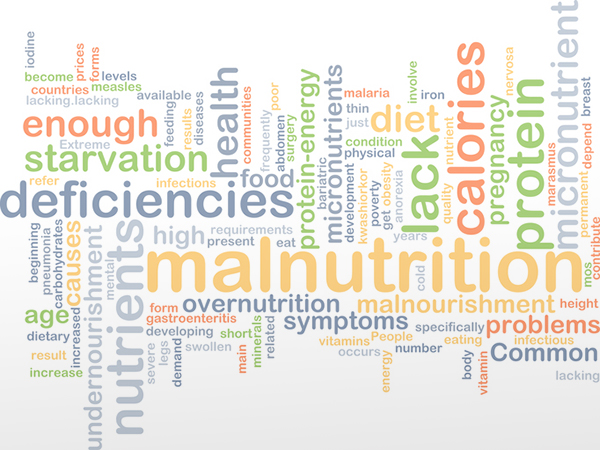Your Location:Home - Hot Topics > - Content
News and Information
What is Malnutrition?
Time:2017-05-03 11:02:45
Source:Academy of Nutrition and Dietetics

Malnutrition is a common and detrimental condition that must be addressed quickly and comprehensively. Registered dietitian nutritionists are working hard to improve the speed and accuracy of malnutrition diagnosis and nutrition interventions in health care. Malnutrition is a physical state of unbalanced nutrition. It can mean undernutrition or overnutrition. When most people think of malnutrition, they usually picture undernutrition, which can be caused by a lack of calories, protein or other nutrients. This occurs frequently in areas of the world without adequate access to food and clean drinking water.
Overnutrition comes from eating too many calories. Someone can be obese and malnourished at the same time. They may be consuming enough, or too many, calories but not eating enough nutritious foods like fruits, vegetables, whole grains, lean protein, beans, low-fat dairy, nuts and seeds. This can result in vitamin, mineral or protein deficiencies. In the United States, this is commonly seen in the hunger and overweight paradox, which occurs mostly in food insecure, impoverished areas.
Clinical malnutrition is when a hospital patient becomes malnourished. Estimates of adult malnutrition range from 15 percent to 60 percent of hospitalized patients. There are many reasons why someone in the hospital may not be getting enough nutrition. For example, their body requires more nutrition than usual or they are not able to absorb the nutrients they eat. Some hospital patients need to receive nutrition through a tube inserted into their stomach or even intravenous nutrition, where the digestive tract is bypassed altogether.
It is important that malnutrition is diagnosed in a timely manner. When a hospital patient becomes malnourished their medical treatment and recovery are affected. Research shows that malnutrition increases the risk of death, length of hospital stay and health care costs. Hospitals are required to screen for malnutrition within 24 hours of patient admission.
Registered dietitian nutritionists make recommendations and work with the health care team to help patients receive the nutrition they need. RDNs assess malnutrition using weight history, dietary intake, lab values and a physical exam. A nutrition-focused physical exam involves checking for body fat and muscle loss, fluid accumulation and hand grip strength. The Centers for Medicare and Medicaid Services requires long-term care facilities to employ registered dietitian nutritionists to manage the nutrition care of residents.
Malnutrition also can be the result of an eating disorder, organ failure or severe infection or physical trauma like a head injury. Malnutrition frequently occurs in the older adult population, especially in those with dementia or Alzheimer’s disease. Approximately 14 percent of nursing home residents and upwards of 50 percent of rehab facility patients are malnourished.
Tooth loss and other dental issues, loss of appetite and functional decline are contributing factors to malnutrition among older adults.
Overnutrition comes from eating too many calories. Someone can be obese and malnourished at the same time. They may be consuming enough, or too many, calories but not eating enough nutritious foods like fruits, vegetables, whole grains, lean protein, beans, low-fat dairy, nuts and seeds. This can result in vitamin, mineral or protein deficiencies. In the United States, this is commonly seen in the hunger and overweight paradox, which occurs mostly in food insecure, impoverished areas.
Clinical malnutrition is when a hospital patient becomes malnourished. Estimates of adult malnutrition range from 15 percent to 60 percent of hospitalized patients. There are many reasons why someone in the hospital may not be getting enough nutrition. For example, their body requires more nutrition than usual or they are not able to absorb the nutrients they eat. Some hospital patients need to receive nutrition through a tube inserted into their stomach or even intravenous nutrition, where the digestive tract is bypassed altogether.
It is important that malnutrition is diagnosed in a timely manner. When a hospital patient becomes malnourished their medical treatment and recovery are affected. Research shows that malnutrition increases the risk of death, length of hospital stay and health care costs. Hospitals are required to screen for malnutrition within 24 hours of patient admission.
Registered dietitian nutritionists make recommendations and work with the health care team to help patients receive the nutrition they need. RDNs assess malnutrition using weight history, dietary intake, lab values and a physical exam. A nutrition-focused physical exam involves checking for body fat and muscle loss, fluid accumulation and hand grip strength. The Centers for Medicare and Medicaid Services requires long-term care facilities to employ registered dietitian nutritionists to manage the nutrition care of residents.
Malnutrition also can be the result of an eating disorder, organ failure or severe infection or physical trauma like a head injury. Malnutrition frequently occurs in the older adult population, especially in those with dementia or Alzheimer’s disease. Approximately 14 percent of nursing home residents and upwards of 50 percent of rehab facility patients are malnourished.
Tooth loss and other dental issues, loss of appetite and functional decline are contributing factors to malnutrition among older adults.
Last articleChoose Healthy Fat
Next article最后一页



